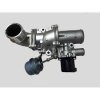liviunicolas
New Member
- Posts
- 9
Hello colleagues! I'm new to the forum and using google translate, so I apologize for any spelling mistakes.
I own a Range Rover Sport 3.0Diesel sdv6 2010.
for a week I have been facing the following problem, my performance limited to higher accelerations when I exceed 2500rpm. when I take my foot off the accelerator, the red triangle appears and I break down.. I have to stop the engine, and wait 1-2 minutes.. then I restart it and everything is ok until the next acceleration. the diagnostic gives me the following errors:
1- p00bd-07 Air flow mass or volume of a circuit Range/performance - Air flow too high
2- p22d2-77 Turbocharger Turbine Inlet Valve Stuck Open
3- p22cf-71 Turbocharger Turbine Intake Valve Control Circuit -Open
I am also attaching a photo of the error codes.
and around 1800-2000rpm it seems to lose air somewhere. I'm not sure if that's what it's supposed to sound like, or am I really missing something somewhere?
please, if anyone else has gone through this and solved it, tell me what the solution was.
what I tried to do, I removed the plastic shield near the left wheel where the vacuum operated valve is to check if it is not blocked.. it seems to be fine!
thank you and I await your opinions
I own a Range Rover Sport 3.0Diesel sdv6 2010.
for a week I have been facing the following problem, my performance limited to higher accelerations when I exceed 2500rpm. when I take my foot off the accelerator, the red triangle appears and I break down.. I have to stop the engine, and wait 1-2 minutes.. then I restart it and everything is ok until the next acceleration. the diagnostic gives me the following errors:
1- p00bd-07 Air flow mass or volume of a circuit Range/performance - Air flow too high
2- p22d2-77 Turbocharger Turbine Inlet Valve Stuck Open
3- p22cf-71 Turbocharger Turbine Intake Valve Control Circuit -Open
I am also attaching a photo of the error codes.
and around 1800-2000rpm it seems to lose air somewhere. I'm not sure if that's what it's supposed to sound like, or am I really missing something somewhere?
please, if anyone else has gone through this and solved it, tell me what the solution was.
what I tried to do, I removed the plastic shield near the left wheel where the vacuum operated valve is to check if it is not blocked.. it seems to be fine!
thank you and I await your opinions
Attachments
Last edited:


